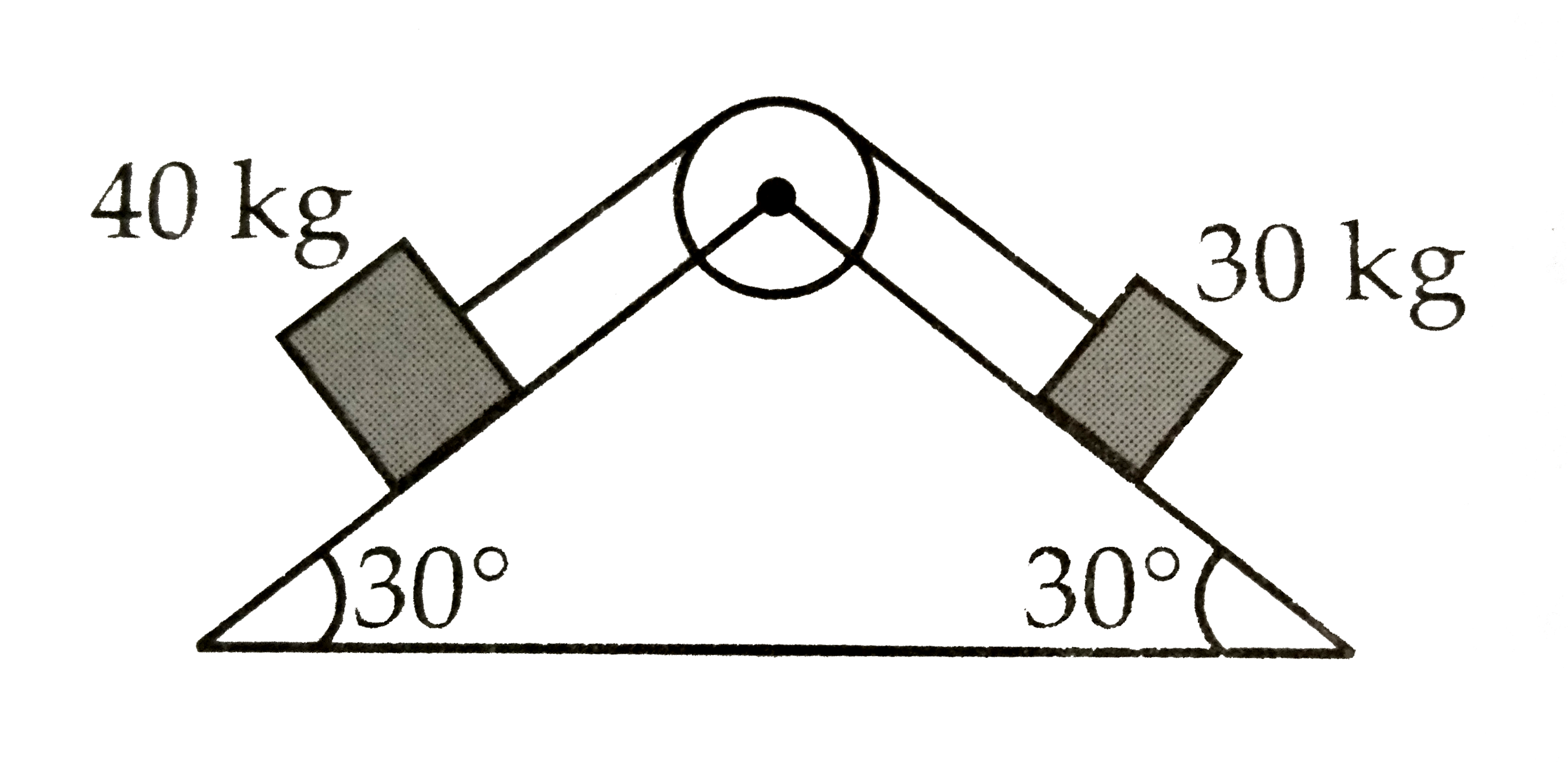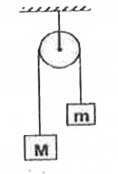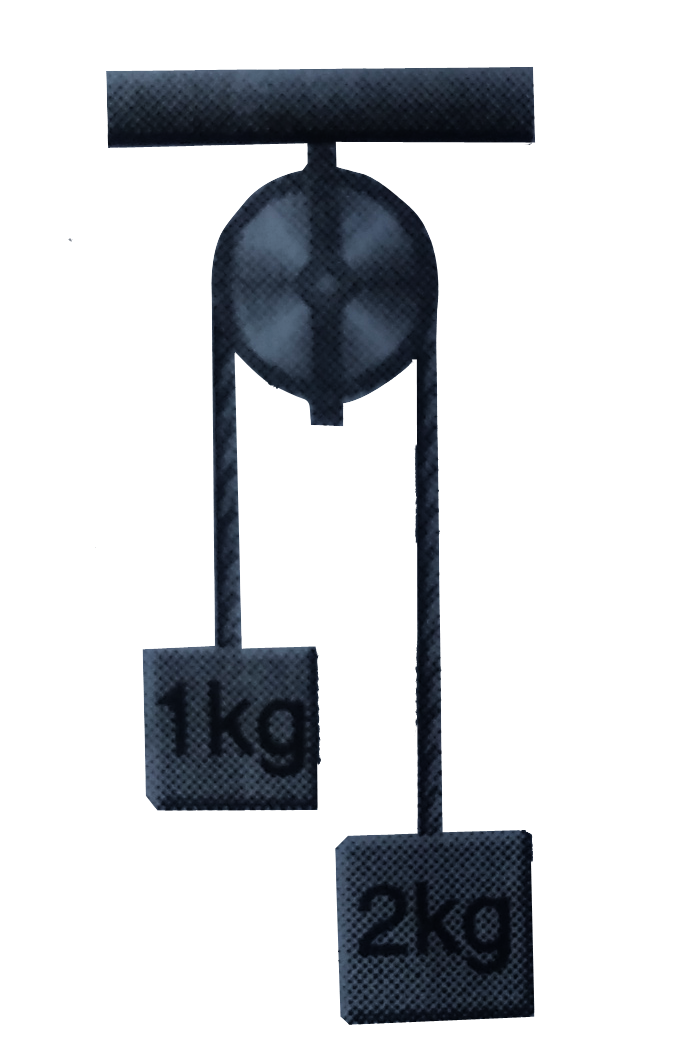Two bodies of masses 1 kg and 2 kg are connected by a very light string passed over a clamped light smooth pulley. If the system is released from rest, find the acceleration of the two masses and the tension in the string
3.27m/s2,13N
4.5m/s2,13N
1.27m/s2,13N
0.327m/s2,13N
The correct Answer is:A
To solve the problem of two bodies connected by a string over a pulley, we will follow these steps:
Step 1: Identify the Forces Acting on Each Mass
- For the 1 kg mass (m1):
- Weight (W1) = m1 * g = 1 kg * 9.8 m/s² = 9.8 N (acting downwards)
- Tension (T) in the string (acting upwards)
- For the 2 kg mass (m2):
- Weight (W2) = m2 * g = 2 kg * 9.8 m/s² = 19.6 N (acting downwards)
- Tension (T) in the string (acting upwards)
Step 2: Write the Equations of Motion
- For the 1 kg mass (m1):
T−W1=m1⋅a⟹T−9.8=1⋅a(1)
- For the 2 kg mass (m2):
W2−T=m2⋅a⟹19.6−T=2⋅a(2)
Step 3: Solve the Equations Simultaneously
- From Equation (1):
T=a+9.8(3)
- Substitute Equation (3) into Equation (2):
19.6−(a+9.8)=2a
19.6−9.8−a=2a
9.8=3a
a=9.83≈3.27m/s2
Step 4: Calculate the Tension in the String
- Substitute the value of a back into Equation (3):
T=3.27+9.8=13.07N≈13N
Final Results
- The acceleration of the two masses is approximately 3.27m/s2.
- The tension in the string is approximately 13N.
- For the 1 kg mass (m1):
- Weight (W1) = m1 * g = 1 kg * 9.8 m/s² = 9.8 N (acting downwards)
- Tension (T) in the string (acting upwards)
- Weight (W2) = m2 * g = 2 kg * 9.8 m/s² = 19.6 N (acting downwards)
- Tension (T) in the string (acting upwards)
- For the 1 kg mass (m1):
T−W1=m1⋅a⟹T−9.8=1⋅a(1)
W2−T=m2⋅a⟹19.6−T=2⋅a(2)
- From Equation (1):
T=a+9.8(3)
19.6−(a+9.8)=2a
19.6−9.8−a=2a
9.8=3a
a=9.83≈3.27m/s2
- Substitute the value of a back into Equation (3):
T=3.27+9.8=13.07N≈13N
- The acceleration of the two masses is approximately 3.27m/s2.
- The tension in the string is approximately 13N.
Similar Questions
Two masses 2 kg and 4 kg are connected at the two ends of light inextensible string passing over a frictionless pulley. If the masses are released, then find the acceleration of the masses and the tension in the string.
View SolutionTwo masses 2 kg and 4 kg are connected at two ends of light inextensible string passing over a frictionless pulley . If the masses are released , then find the accelaration of the masses and the tension in the string .
View Solution
Knowledge Check
Two blocks of masses of 40 kg and 30 kg are connected by a weightless string passing over a frictionless pulley as shown in the figure.
 A0.7ms−2B0.8ms−2C0.6ms−2D0.5ms−2
A0.7ms−2B0.8ms−2C0.6ms−2D0.5ms−2
Two blocks of masses 6kg and 4kg are attached to the two ends of a massless string passing over a smooth fixed pulley. if the system is released, the acceleration of the centre of mass of the system will be
View SolutionTwo particles having mass ratio n:1 are interconnected by a light inextensible string that passes over a smooth pulley . If the system is released , then the acceleration of the centre of mass of the system is
View SolutionTwo unequal masses are connected by a very light string over a clamped light smooth pulley. Find the acceleration of the system and the tension in the string.
View SolutionTwo blocks of masses 10 kg and 9 kg are connected with light string which is passing over an ideal pulley as shown in figure. If system is released from rest then the acceleration of 9 kg block at the given instant is about (Assume all the surfaces are smooth and g=10ms2)
View SolutionTwo masses m and M(m<M) are joined by a light string passing over a smooth and light pulley (as shown)

View SolutionTwo unequal masses of 1kg and 2kg are connected by a string going over a clamed light smooth pulley as shown in figure . The system is released from rest .The larger mass is stopped for a moment 1.0s after the system is set in motion.Find the time elapsed before the string is tight again.

View SolutionTwo bodies of masses m1 and m2 are connected a light string which passes over a frictionless massless pulley. If the pulley is moving upward with uniform acceleration g2, then tension in the string will be
View Solution
